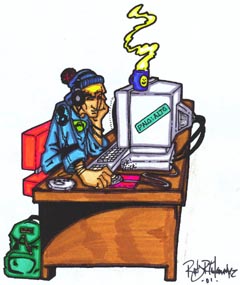Pulse Staff Reporter
Web courses offer students the flexibility to work around their hectic schedule; however, Web courses aren’t for everyone.
“It’s not so much students failing the class, but students dropping the course,” said Javier Aguirre, History professor. His classes begin with about twenty students, but by the end of the semester only half remain.
In the Fall of 1999, the failure

Cartoon By Rudy Talmantez
Students
tend to fall behind, which causes them to drop out. Students and professors
all around Palo Alto agree Web classes are not designed for every student.
Gregorio Salinas, Political Science major, points out, “It’s easy to say, ‘oh I’ll just do it later.’ Later turns into too late.”
Anita Carrejo, secretary of the History Department, also a Computer Information Systems major. “Internet courses are not for every student,” said Carrejo. “You have to be self-motivated and disciplined because you are doing the work on your schedule. Once you get behind, it’s very hard to catch up.”Web classes have become a popular trend of the millennial student. Palo Alto went from offering 18 World Wide Web classes in the Fall of 1999 to almost 90 Internet courses this Spring.
Some students enroll in Internet classes because the traditional courses are filled up or they want the flexibility the courses offer.
Web courses require different material than a regular course. A Web site is available to guide students through what to expect in Web classes. Information, such as course description, web CT, and even a survey to check if you are Internet material.
Students who have enrolled in Web classes have experienced some technical problems. Salinas said, “One big problem is sometimes the server doesn’t respond, which causes students not to get to their work.”
One student recounted taking a timed quiz online and being kicked off of the server. The student was unable to get back onto the quiz site and her time ran out.
“It was the second to the last day to turn in a quiz. The server was down, so practically the entire class did not take the quiz by the deadline,” Salinas said.
Part of the trouble with Internet courses was that Palo Alto’s computer hardware was not adequate. Palo Alto hired Frances Cisneros, computer system analysis, more than a year ago to help the campus with these technical problems.
Internet classes have come a long way. Instead of giving assignments via-email, instructors are actually able to communicate with students through a chat room especially developed for the Alamo Community College District. Here, students are able to speak to the professor and their classmates and get immediate response.
Web classes begin with orientation where students are able to get acquainted with the professor in person. Once the class begins, students keep in contact via e-mail.
Rob Hines, History professor, has been teaching History 1301 online for about two years. “Not all the students show up for orientation,” Hines said.
Most students who enroll in Web classes tend to be non-traditional students. Those who are parents, who have a hectic schedule or who are in the military find that Internet courses meet their needs.
“I notice that some of the homework was sent around 1:00 in the morning,” said Aguirre.
Palo Alto’s Distance Education Department helped develop Internet courses to assist students whose busy lifestyles make scheduling traditional college courses difficult.
Being in an Internet class enables you to work around your schedule and helps to reduce the trips to and from campus. Students who take Internet courses agree that it saves gas.
“The main reason I chose an Internet course was because of the flexibility it allowed,” Salinas said. “Web classes have made it possible to keep my job at Brooks Air Force Base.”
Steven Perez, a United States Marine stationed in Norfolk, Virginia, said: “Being in the military, you don’t have all the time in the world, especially to come to class everyday, Internet courses help, because I can schedule my classes around my job, not the other way around.”
Hines agreed that Internet courses have their disadvantages, but Web classes also offer a great deal.
“The class allowed me to build good time management skills,” Carrejo said.
A few of the professors said that the Internet courses not only benefit the student, but they also benefit them as well. Professors, like Hines and Michael Seiferth, English professor, believe that Internet classes have enabled them to be more computer literate.
Seiferth was one of the first instructors to teach an Internet course at Palo Alto. He finds it fascinating to teach on the Web. “I get students from all over the world, like students in Europe,” said Seiferth.
Even though most professors enjoy a new form of teaching, there are still some who like the interactive classroom scene.
“I like being in the classroom, being able to see and interact with my students,” Aguirre said.
Students, like Salinas, agree that while Web classes are good, traditional classes will not become obsolete. “One of the disadvantages of Internet courses is the loss of interaction between you and the professor,” he said.
Before deciding to enroll in an Internet course, take the survey provided by Palo Alto on the Distance Education Web site.
For more information, call 921-5303 or go to www.accd.edu/cyberlrn